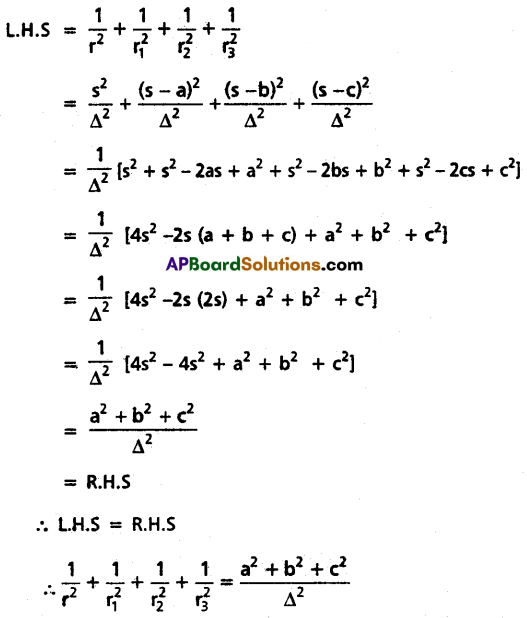Thoroughly analyzing TS Inter 1st Year Maths 1A Model Papers and TS Inter 1st Year Maths 1A Question Paper March 2019 helps students identify their strengths and weaknesses.
TS Inter 1st Year Maths 1A Question Paper March 2019
Time: 3 Hours
Maximum Marks: 75
Note: This question paper consists of three sections A, B, and C.
Section – A
(10 × 2 = 20 Marks)
I. Very Short Answer Type Questions.
- Answer all questions.
- Each question carries two marks.
Question 1.
If f(x) = 2x – 1, g(x) = \(\frac{x+1}{2}\) for all x ∈ R, are two functions, then find:
(i) (gof) (x)
(ii) (fog) (x)
Solution:
Given f(x) = 2x – 1 and g(x) = \(\frac{x+1}{2}\)
(i) (gof) (x) = g[f(x)]
= g[2x – 1]
= \(\frac{2 x-1+1}{2}\)
= x
∴ (gof) (x) = x.
(ii) (fog) (x) = f[g(x)]
= f[latex]\frac{x+1}{2}[/latex]
= 2[latex]\frac{x+1}{2}[/latex] – 1
= x + 1 – 1
= x
∴ (fog) (x) = x
Question 2.
Find the domain of the real valued function f(x) = \(\frac{1}{6 x-x^2-5}\).
Solution:
Given f(x) = \(\frac{1}{6 x-x^2-5}\) ∈ R
∴ 6x – x2 – 5 ≠ 0
⇒ x2 – 6x + 5 ≠ 0
⇒ x2 – 5x – x + 5 ≠ 0
⇒ x(x – 5) – 1(x – 5) ≠ 0
⇒ (x – 1) (x – 5) ≠ 0
⇒ x ≠ 1 and x ≠ 5
∴ Domain of f = R – {1, 5}
![]()
Question 3.
If A = \(\left[\begin{array}{lll}
1 & 2 & 3 \\
3 & 2 & 1
\end{array}\right]\) and B = \(\left[\begin{array}{lll}
3 & 2 & 1 \\
1 & 2 & 3
\end{array}\right]\) then find 3B – 2A.
Solution:
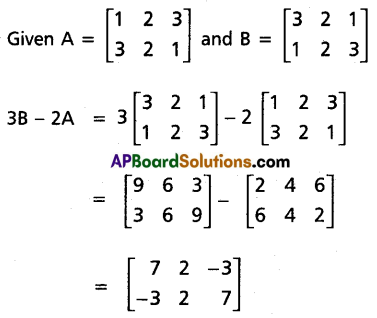
Question 4.
If A = \(\left[\begin{array}{rrr}
2 & 0 & 1 \\
-1 & 1 & 5
\end{array}\right]\) and B = \(\left[\begin{array}{rrr}
-1 & 1 & 0 \\
0 & 1 & -2
\end{array}\right]\) then find (ABT)T.
Solution:

Question 5.
If \(\overline{\mathrm{OA}}=\overline{\mathrm{i}}+\overline{\mathrm{j}}+\overline{\mathrm{k}}, \overline{\mathrm{AB}}=3 \overline{\mathrm{i}}-2 \overline{\mathrm{j}}+\overline{\mathrm{k}}, \overline{\mathrm{BC}}=\overline{\mathrm{i}}+2 \overline{\mathrm{j}}-2 \overline{\mathrm{k}}\), \(\overline{C D}=2 \bar{i}+\bar{j}+3 \bar{k}\) then find the vector \(\bar{OD}\).
Solution:

Question 6.
Let \(\bar{a}=2 \bar{i}+4 \bar{j}-5 \bar{k}, \bar{b}=\bar{i}+\bar{j}+\bar{k}\) be three vectors. Find the unit vector in the opposite direction of \(\bar{a}+\bar{b}+\bar{c}\).
Solution:
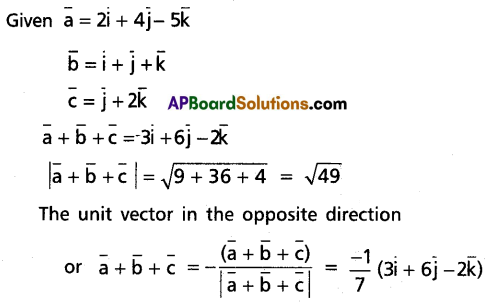
Question 7.
Find the equation of the plane passing through the point (3, -2, 1) and perpendicular to the vector (4, 7, -4).
Solution:
The equation of the plane passing through the point (3, -2, 1) and perpendicular to the vector (4, 7, -4) is 4(x – 3) + 7(y + 2) – 4(z – 1) = 0
⇒ 4x – 12 + 7y + 14 – 4z + 4 = 0
⇒ 4x + 7y – 4z + 6 = 0
Question 8.
If sin θ = \(-\frac{1}{3}\) and θ do not lie in the third quadrant, then find the values of:
(i) cos θ
(ii) cot θ
Solution:
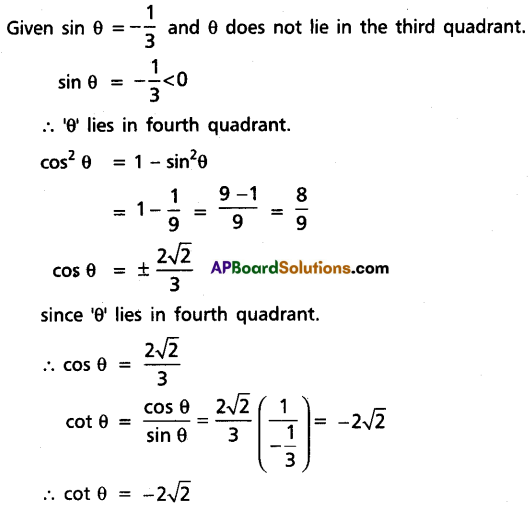
Question 9.
Evaluate \(\sin ^2 82 \frac{1}{2}^{\circ}-\sin ^2 22 \frac{1}{2}^{\circ}\).
Solution:
\(\sin ^2 82 \frac{1}{2}^{\circ}-\sin ^2 22 \frac{1}{2}^{\circ}\)
= \(\sin \left(82 \frac{1}{2}^{\circ}+22 \frac{1}{2}^{\circ}\right) \cdot \sin \left(82 \frac{1}{2}^{\circ}-22 \frac{1}{2}^{\circ}\right)\)
= sin 105° . sin 60°
= sin (90° + 15°) . sin 60°
= cos 15° . sin 60°
= \(\frac{\sqrt{3}+1}{2 \sqrt{2}} \cdot \frac{\sqrt{3}}{2}\)
= \(\frac{1}{4 \sqrt{2}}(3+\sqrt{3})\)
![]()
Question 10.
If cosh x = \(\frac{5}{2}\), then find cosh (2x) and sinh (2x).
Solution:
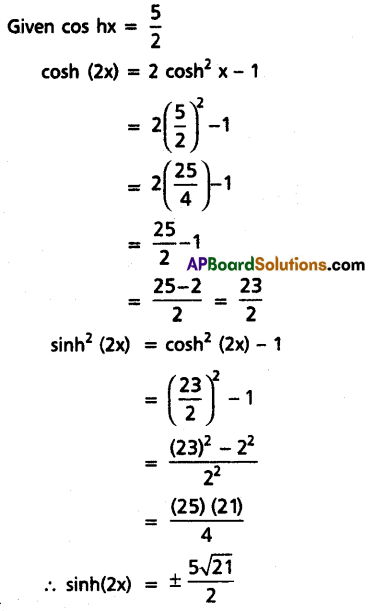
Section – B
(5 × 4 = 20 Marks)
II. Short Answer Type Questions.
- Answer any five questions.
- Each question carries four marks.
Question 11.
If A = \(\left[\begin{array}{ccc}
1 & -2 & 1 \\
0 & 1 & -1 \\
3 & -1 & 1
\end{array}\right]\), then find A3 – 3A2 – A – 3I, where I is unit matrix of order 3.
Solution:
Given A = \(\left[\begin{array}{ccc}
1 & -2 & 1 \\
0 & 1 & -1 \\
3 & -1 & 1
\end{array}\right]\)
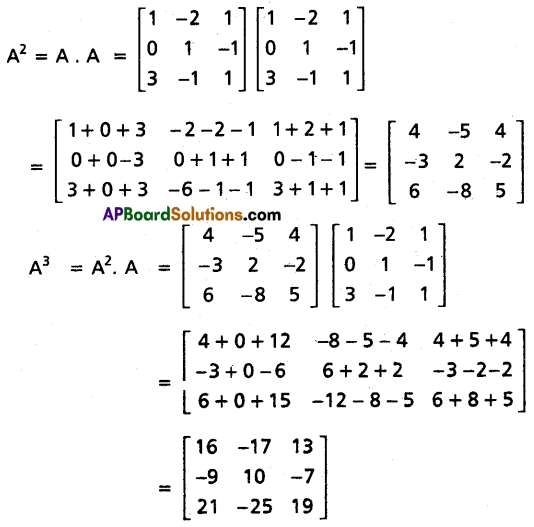
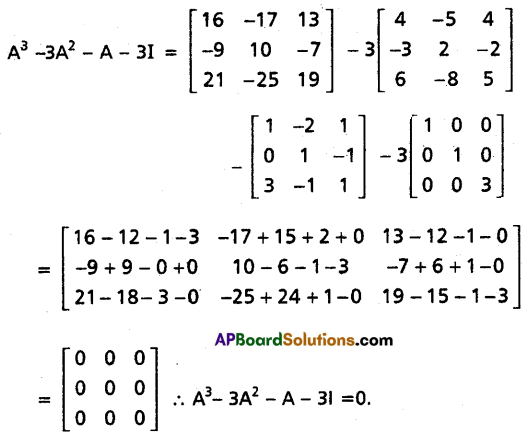
Question 12.
If \(\bar{a}, \bar{b}, \bar{c}\) are non-coplanar vectors, then find the point of intersection of the line passing through the points \(2 \bar{a}+3 \bar{b}-\bar{c}\), \(3 \bar{a}+4 \bar{b}-2 \bar{c}\) with the line joining the points \(\bar{a}-2 \bar{b}+3 \bar{c}\), \(\overline{\mathrm{a}}-6 \overline{\mathrm{b}}+6 \overline{\mathrm{c}}\).
Solution:
The vector equation of the line through the points

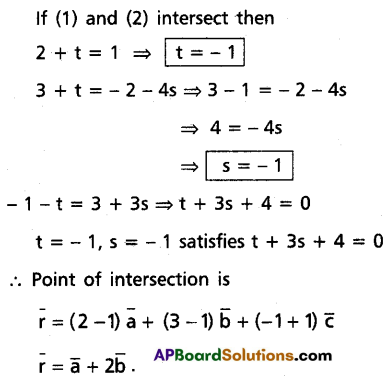
Question 13.
If \(\overline{\mathrm{a}}=2 \overline{\mathrm{i}}+3 \overline{\mathrm{j}}+4 \overline{\mathrm{k}}, \overline{\mathrm{b}}=\overline{\mathrm{i}}+\overline{\mathrm{j}}-\overline{\mathrm{k}}\) and \(\overline{\mathrm{c}}=\overline{\mathrm{i}}-\overline{\mathrm{j}}+\overline{\mathrm{k}}\), then compute compute \(\overline{\mathrm{a}} \times(\overline{\mathrm{b}} \times \overline{\mathrm{c}})\) and verify that it is perpendicular to a.
Solution:
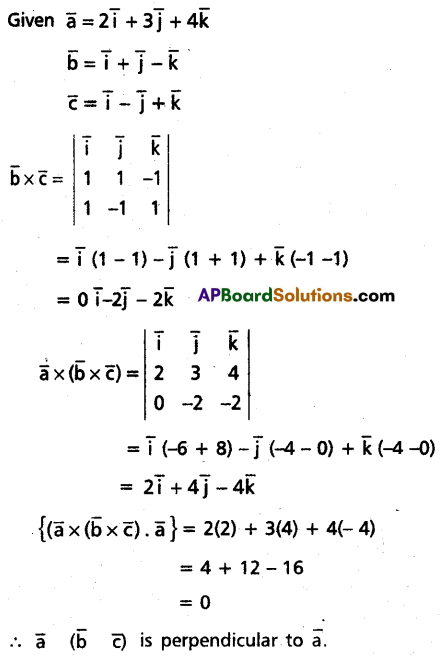
Question 14.
Prove that \(\left(1+\cos \frac{\pi}{10}\right)\left(1+\cos \frac{3 \pi}{10}\right)\left(1+\cos \frac{7 \pi}{10}\right)\left(1+\cos \frac{9 \pi}{10}\right)=\frac{1}{16}\).
Solution:
L.H.S = \(\left(1+\cos \frac{\pi}{10}\right)\left(1+\cos \frac{3 \pi}{10}\right)\left(1+\cos \frac{7 \pi}{10}\right)\left(1+\cos \frac{9 \pi}{10}\right)\)
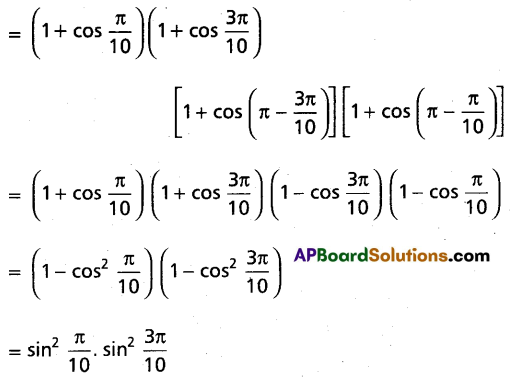
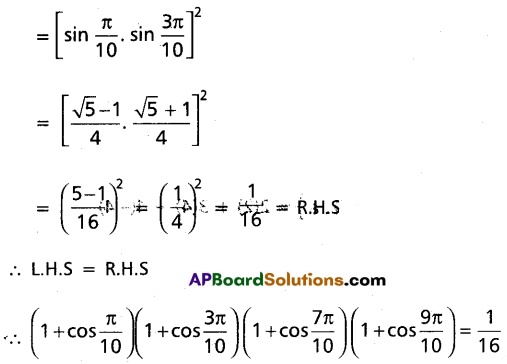
Question 15.
If θ1, θ2 are solutions of the equation a cos 2θ + b sin 2θ = c, tan θ1 ≠ tan θ2 and a + c ≠ 0, then find the values of
(i) tan θ1 + tan θ2
(ii) tan θ1 . tan θ2
Solution:
Given a cos 2θ + b sin 2θ = c
⇒ \(a\left(\frac{1-\tan ^2 \theta}{1+\tan ^2 \theta}\right)+b\left(\frac{2 \tan \theta}{1+\tan ^2 \theta}\right)\) = c
⇒ a(1 – tan2θ) + 2b tan θ = c(1 + tan2θ)
⇒ a – a tan2θ + 2b tan θ = c + c tan2θ
⇒ (a + c) tan2θ – 2b tan θ + (c – a) = 0
This is a second-degree quadratic equation in tan θ
Its solutions be tan θ1, tan θ2.
(i) Sum of the roots = tan θ1 + tan θ2
= \(\frac{-(-2 b)}{a+c}\)
= \(\frac{2 b}{a+c}\)
(ii) Product of the roots = tan θ1 . tan θ2 = \(\frac{c-a}{c+a}\)
![]()
Question 16.
Prove that \(\sin ^{-1}\left(\frac{3}{5}\right)+\sin ^{-1}\left(\frac{8}{17}\right)=\cos ^{-1}\left(\frac{36}{85}\right)\).
Solution:
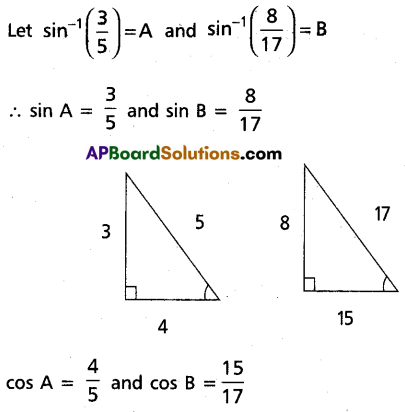

Question 17.
In a triangle ABC, if \(\frac{1}{a+c}+\frac{1}{b+c}=\frac{3}{a+b+c}\), then show that C = 60°.
Solution:
Given \(\frac{1}{a+c}+\frac{1}{b+c}=\frac{3}{a+b+c}\)
⇒ \(\frac{b+c+a+c}{(a+c)(b+c)}=\frac{3}{a+b+c}\)
⇒ (a + b + 2c) (a + b + c) = 3(a + c) (b + c)
⇒ a2 + ab + ac + ab + b2 + bc + 2ac + 2bc + 2c2 = 3ab + 3ac + 3bc + 3c2
⇒ a2 + b2 – c2 = ab
⇒ 2ab cos C = ab
⇒ cos C = \(\frac{1}{2}\)
⇒ C = 60°
Section – C
(5 × 7 = 35 Marks)
III. Long Answer Type Questions.
- Answer any five questions.
- Each question carries Seven marks.
Question 18.
If f: A → B is a bijection, IA and IB are identity functions on A and B respectively, then show that fof-1 = IB and f-1of = IA.
Question 19.
Using mathematical induction, prove that \(\left(1+\frac{3}{1}\right)\left(1+\frac{5}{4}\right)\left(1+\frac{7}{9}\right) \cdots \cdots\left(1+\frac{2 n+1}{n^2}\right)\) = (n + 1)2, ∀ n ∈ N.
Solution:
Let S(n) be the statement that
\(\left(1+\frac{3}{1}\right)\left(1+\frac{5}{4}\right)\left(1+\frac{7}{9}\right) \cdots \cdots\left(1+\frac{2 n+1}{n^2}\right)\) = (n + 1)2
If n = 1 then
LH.S = (1 + \(\frac{3}{1}\))
= 1 + 3
= 4
R.H.S = (1 + 1)2 = 4
∴ L.H.S = R.H.S
∴ S(1) is true.
Assume that S(K) is true.

∴ S(K + 1) is true.
By the principle of mathematical induction S(n) is true for all n ∈ N.
∴ \(\left(1+\frac{3}{1}\right)\left(1+\frac{5}{4}\right)\left(1+\frac{7}{9}\right) \cdots \cdots\left(1+\frac{2 n+1}{n^2}\right)\) = (n + 1)2
Question 20.
Show that \(\left|\begin{array}{ccc}
a+b+2 c & a & b \\
c & b+c+2 a & b \\
c & a & c+a+2 b
\end{array}\right|\) = 2(a + b + c)3.
Solution:

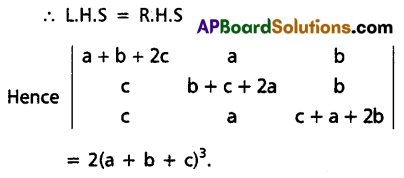
Question 21.
Solve 3x + 4y + 5z = 18, 2x – y + 8z = 13 and 5x – 2y + 7z = 20 by using Matrix inversion method.
Solution:
Given 3x + 4y + 5z = 18
2x – y + 8z = 13
5x – 2y + 7z = 20
The given system of equations can be written as AX = B
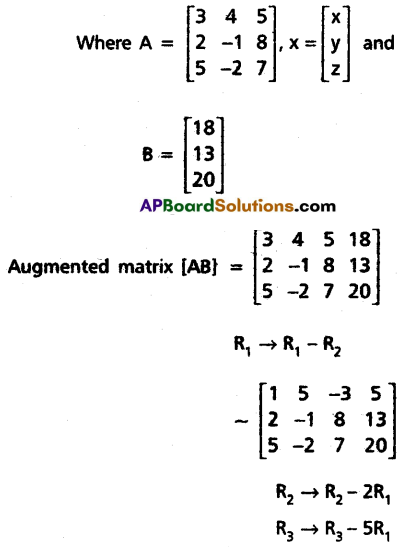

∴ x = 3, y = 1, z = 1
Question 22.
If A = (1, -2, -1), B = (4, 0, -3), C = (1, 2, -1) and D = (2, -4, – 5) are four points, then find the shortest distance between the skew lines \(\stackrel{\leftrightarrow}{\mathrm{AB}}\) and \(\stackrel{\leftrightarrow}{\mathrm{CD}}\).
Question 23.
If A, B, C are angled in a triangle, then prove that cos A + cos B – cos C = -1 + 4 \(\cos \frac{A}{2} \cos \frac{B}{2} \sin \frac{C}{2}\).
Solution:

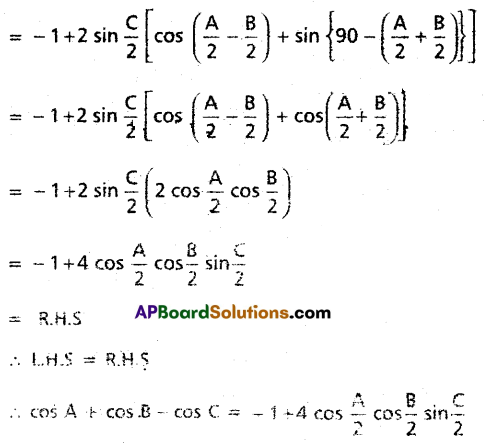
![]()
Question 24.
If ΔABC, show that \(\frac{1}{r^2}+\frac{1}{r_1^2}+\frac{1}{r_2^2}+\frac{1}{r_3^2}=\frac{a^2+b^2+c^2}{\Delta^2}\).
Solution:
